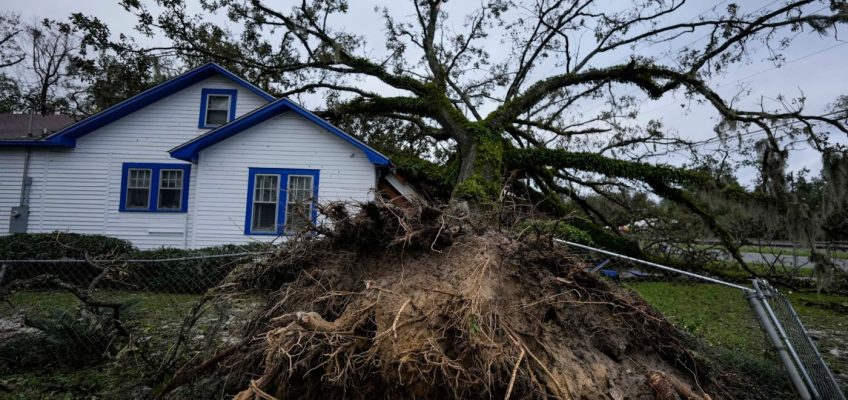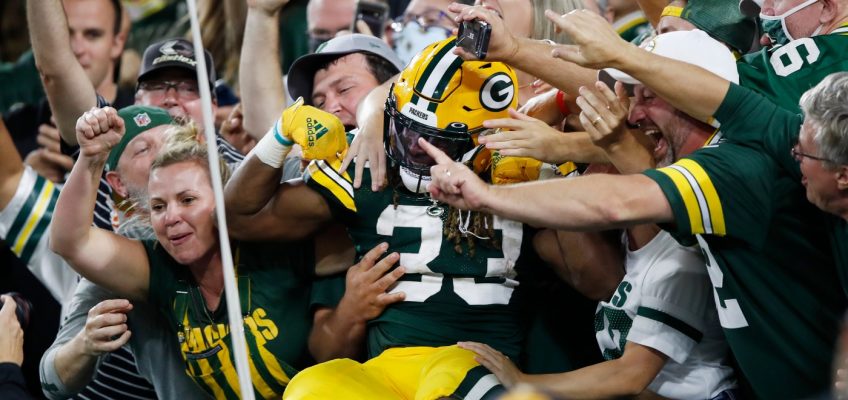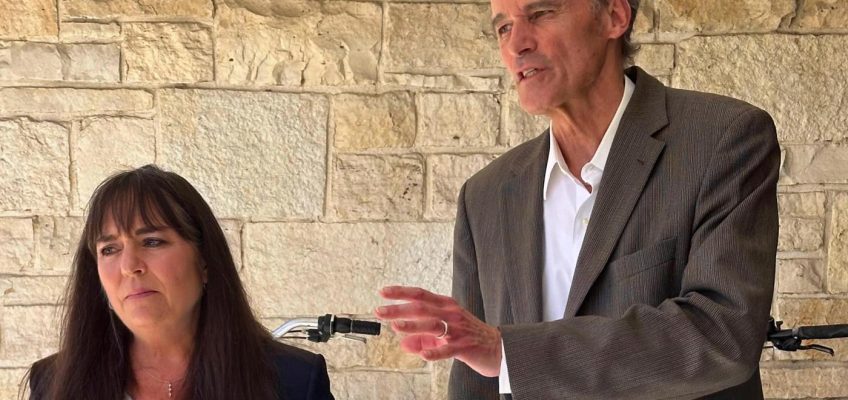Emergency crews are rushing to rescue people trapped in flooded homes after Helene roared ashore as a powerful Category 4 hurricane in Florida. The system generated a massive storm surge and knocked out power to millions of customers in several states.
At least six people were reported dead.
The storm made landfall late Thursday in a sparsely populated region with maximum sustained winds of 140 mph in the rural Big Bend area. That region is home to fishing villages and vacation hideaways where Florida’s Panhandle and peninsula meet.
But the damage extended hundreds of miles to the north, with flooding as far away as North Carolina.
Jamir Lewis wades through floodwaters with his two daughters, Nylah and Aria, in the aftermath of Hurricane Helene on Friday, Sept. 27, 2024 in Crystal River, Fla. (Luis Santana/Tampa Bay Times via AP)
A Citrus County Firefigher carries 11-year-old, Michael Cribbins, while conducting rescues from floodwaters in the aftermath of Hurricane Helene on Friday, Sept. 27, 2024 in Crystal River, Fla. (Luis Santana/Tampa Bay Times via AP)
Andrew Lucky, 54, speaks about the water damage to his house caused by a flood from Hurricane Helene near DeSoto Park, Fla., on Friday, Sept. 27, 2024, in Tampa. (Jefferee Woo/Tampa Bay Times via AP)
Clarissa Lucky gives a tour of her home that flooded from Hurricane Helene near DeSoto Park, Fla., on Friday, Sept. 27, 2024, in Tampa. (Jefferee Woo/Tampa Bay Times via AP)
A boat rests on a street after being relocated during flooding caused by Hurricane Helene Friday, Sept. 27, 2024, in Hudson, Fla. (AP Photo/Mike Carlson)
The streets are flooded near Peachtree Creek after hurricane Helene brought in heavy rains over night on Sept. 27, 2024 in Atlanta, Georgia. (Photo by Megan Varner/Getty Images)
Candace Redwine surveys the damage after about 3 feet of water inundated her Spiceman Kitchen store when Hurricane Helene passed offshore on Sept. 27, 2024 in Tarpon Springs, Florida. (Photo by Joe Raedle/Getty Images)
Union Cathederal church is seen after of Hurricane Helene moved through the area on Friday, Sept. 27, 2024, in Valdosta, Ga. (AP Photo/Mike Stewart)
Union Cathederal church is seen after of Hurricane Helene moved through the area on Friday, Sept. 27, 2024, in Valdosta, Ga. (AP Photo/Mike Stewart)
Union Cathederal church is seen after of Hurricane Helene moved through the area on Friday, Sept. 27, 2024, in Valdosta, Ga. (AP Photo/Mike Stewart)
Vehicles move slowly around trees that have fallen after Hurricane Helene moved through the area, Friday, Sept. 27, 2024, in Valdosta, Ga. (AP Photo/Mike Stewart)
Staff of the Inn On The Gulf clean up after their restaurant flooded with surge from Hurricane Helene Friday, Sept. 27, 2024, in Hudson, Fla. (AP Photo/Mike Carlson)
Rhonda Bell looks on after an Oak tree landed on her 100-year-old home after Hurricane Helene moved through, Friday, Sept. 27, 2024, in Valdosta, Ga. (AP Photo/Mike Stewart)
People and pets are rescued from flooded neighborhoods in the aftermath of Hurricane Helene on Friday, Sept. 27, 2024 in Crystal River, Fla. (Luis Santana/Tampa Bay Times via AP)
An airboat transports residents rescued from floodwaters in the aftermath of Hurricane Helene on Friday, Sept. 27, 2024 in Crystal River, Fla. (Luis Santana/Tampa Bay Times via AP)
Residents wade through a street flooded in the passing of Hurricane Helene, in Batabano, Mayabeque province, Cuba, Thursday, Sept. 26, 2024. (AP Photo/Ramon Espinosa)
Related Articles
Helene lashes the South with wind and sheets of rain. Millions are without power
Feds charge NYC mayor with selling his influence to foreign nationals. He says he won’t resign
Helene makes landfall in northwestern Florida as a Category 4 hurricane
‘Nightmare scenario’: Hurricane Helene will make catastrophic Florida landfall
Woman alleges Sean ‘Diddy’ Combs raped her on video in latest lawsuit




